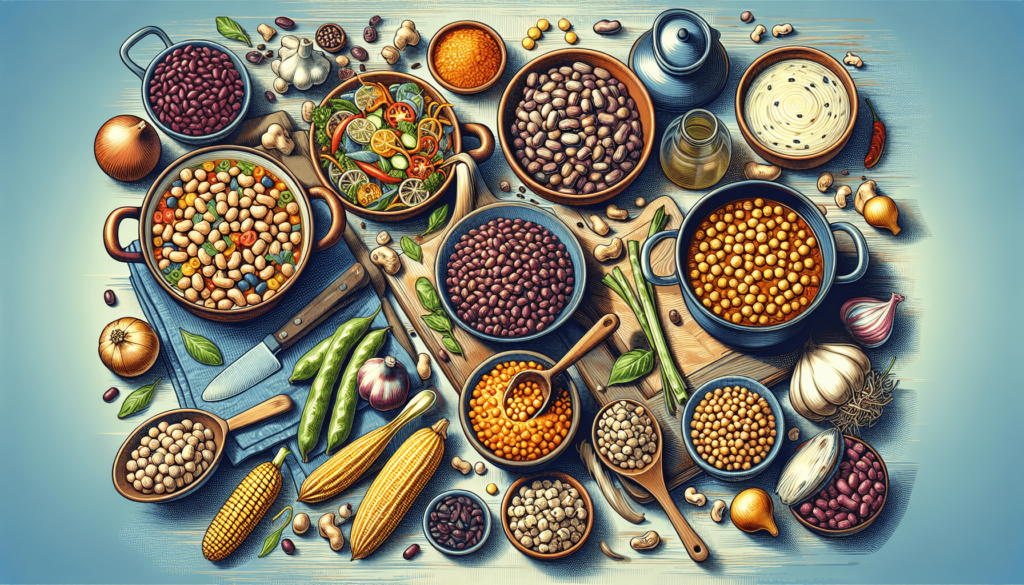Legumes are not only delicious and versatile, but they also offer numerous gut health benefits. If you’re wondering how to make the most of these benefits, there are several simple and effective ways to prepare legumes. From soaking and sprouting to cooking them properly, these methods can optimize the gut health benefits of legumes. So, whether you enjoy them as a delicious side dish or incorporate them into your main meals, preparing legumes the right way can help you enhance their gut health benefits and make the most of their nutritional value.
Soaking and Sprouting Legumes
Legumes are an excellent source of plant-based protein and fiber, but they can sometimes be difficult to digest. This is where soaking and sprouting legumes can be beneficial. Soaking legumes involves submerging them in water for a period of time before cooking, which helps to soften them and reduce cooking time. Sprouting legumes takes this process a step further by allowing them to germinate and develop sprouts. This not only enhances their nutritional value but also improves their digestibility.
Soaking Legumes
To soak legumes, simply place them in a large bowl and cover them with water. The general rule of thumb is to use three cups of water for every cup of legumes. Soak the legumes for at least 4 hours, but preferably overnight. This allows enough time for the legumes to absorb water and soften. After soaking, drain the water and rinse the legumes before cooking them.
Sprouting Legumes
Sprouting legumes adds an extra layer of health benefits to these nutrient-dense foods. To sprout legumes, follow these steps:
- Rinse the legumes thoroughly under running water.
- Place them in a glass jar or a sprouting tray and cover them with water.
- Allow the legumes to soak for 8-12 hours.
- Drain the water and rinse the legumes again.
- Place a cheesecloth or a sprouting lid over the jar to allow air circulation.
- Rinse the legumes twice a day, ensuring they remain moist but not waterlogged.
- After 2-3 days, you’ll start to see sprouts. Let them continue growing until they reach the desired length.
- Rinse the sprouts one last time, drain well, and store them in a sealed container in the refrigerator.
Sprouted legumes are not only easier to digest but also contain increased levels of vitamins, minerals, and enzymes. They also tend to have a milder flavor compared to their unsprouted counterparts.
Cooking Methods for Legumes
After soaking or sprouting legumes, they can be cooked using various methods. Each method has its own advantages and can be chosen based on personal preference and time constraints.
Boiling Legumes
Boiling legumes is the most traditional cooking method. To boil legumes, drain the soaked or sprouted legumes, add fresh water to a pot, and bring it to a boil. Once boiling, reduce the heat to a simmer and cook until the legumes are tender. The time required for boiling legumes can vary depending on the type and size of legumes, but it usually takes between 30 minutes to 2 hours. Boiling legumes can result in a soft, creamy texture, which is ideal for dishes like stews, soups, and purees.
Pressure Cooking Legumes
If you’re short on time, pressure cooking legumes can significantly reduce the cooking time. Pressure cookers use steam and high pressure to speed up the cooking process. To pressure cook legumes, follow these steps:
- Drain the soaked or sprouted legumes and rinse them.
- Place the legumes in the pressure cooker with enough water to cover them.
- Secure the lid and set the pressure cooker to high pressure.
- Cook the legumes for the specified time according to the legume type and size.
- Allow the pressure to release naturally before opening the lid.
Pressure cooking legumes can take anywhere from 5-30 minutes, depending on the legume variety. This method helps to retain more nutrients and can result in a tender texture, making it suitable for dishes like curries, stir-fries, and salads.
Steaming Legumes
Steaming legumes is another healthy option that preserves the flavors and nutrients of the legumes. To steam legumes, place a steamer basket in a pot with water, making sure the water doesn’t touch the bottom of the basket. Drain the soaked or sprouted legumes and place them in the steamer basket. Cover the pot with a lid and bring the water to a boil. Steam the legumes until they are tender, which typically takes around 20-40 minutes depending on the legume variety. Steamed legumes are great for salads, stir-fries, and side dishes.

Adding Gut-Friendly Ingredients
To further enhance the gut health benefits of legumes, you can incorporate various gut-friendly ingredients into your recipes. These ingredients not only contribute to the flavor profile of the dishes but also provide additional health benefits.
Garlic and Onions
Garlic and onions are rich in prebiotic fibers, which act as food for the beneficial bacteria in your gut. These fibers help support the growth of healthy gut flora. Additionally, garlic and onions contain compounds that have antibacterial properties, which can help promote a healthy gut microbiome. Adding minced garlic and onions to legume-based dishes like soups, stews, and sautés can enhance their taste while boosting gut health.
Turmeric
Turmeric is a vibrant yellow spice known for its anti-inflammatory properties. It contains a compound called curcumin, which has been shown to support a healthy gut by reducing inflammation and modulating the gut microbiota. Adding turmeric to legume dishes adds depth of flavor and contributes to overall gut health.
Ginger
Ginger is another spice that can benefit your gut. It has anti-inflammatory and digestive properties that can help soothe the gut and alleviate digestive discomfort. Ginger also aids in the absorption and assimilation of nutrients. Adding grated ginger or ginger powder to legume-based dishes provides a warm and zesty flavor, along with potential digestive benefits.
Pairing Legumes with Probiotics
Probiotics are beneficial bacteria that have a positive impact on gut health. Pairing legumes with probiotic-rich foods can create a symbiotic relationship, where the probiotics enhance the digestion of the legumes and promote a healthy gut microbiome.
Yogurt
Yogurt is one of the most well-known probiotic-rich foods. It contains live cultures of beneficial bacteria that help improve digestion and support gut health. Adding a dollop of plain yogurt to legume-based dishes like curries, chili, or salads can elevate their creaminess and introduce probiotics to your meal.
Kefir
Similar to yogurt, kefir is a fermented milk product packed with probiotics. It has a tangy flavor and a slightly thicker consistency compared to yogurt. Drinking kefir on its own or adding it to smoothies or dressings that accompany legume dishes can provide a probiotic boost to your gut.
Sauerkraut
Sauerkraut is a fermented cabbage dish that is rich in probiotics. The fermentation process results in the growth of beneficial gut bacteria, which can enhance digestion and support gut health. Spooning a helping of sauerkraut onto legume-based dishes like sandwiches, wraps, or Buddha bowls adds a tangy and crunchy element, along with probiotics.

Including Prebiotic-Rich Foods
Prebiotics are non-digestible fibers that promote the growth of beneficial bacteria in the gut. Including prebiotic-rich foods alongside legumes can further optimize their gut health benefits.
Oats
Oats are a great source of prebiotic fibers called beta-glucans. These fibers provide nourishment to the beneficial bacteria in the gut, helping them thrive. Adding cooked oats as a base or incorporating them into baked goods with legumes can create a prebiotic-rich and gut-friendly combination.
Bananas
Bananas are another prebiotic-rich food that pairs well with legumes. They contain a type of fiber called resistant starch, which passes through the digestive system intact and acts as food for the gut bacteria. Slicing bananas onto legume-based breakfast bowls, smoothies, or desserts can add natural sweetness and prebiotic benefits.
Artichokes
Artichokes are a versatile vegetable that is a good source of prebiotic fibers. These fibers are not broken down in the small intestine and instead reach the large intestine, where they fuel the growth of beneficial gut bacteria. Incorporating artichoke hearts into legume salads, dips, or side dishes can contribute to a prebiotic-rich meal.
Combining Legumes with Whole Grains
Combining legumes with whole grains creates a complete protein source, offering all the essential amino acids. This combination also provides a good balance of complex carbohydrates, fiber, and various nutrients. Here are some whole grains that pair well with legumes:
Brown Rice
Brown rice is a nutritious whole grain that complements legumes perfectly. It has a nutty flavor and a slightly chewy texture, which pairs well with the creaminess of legumes. Combining cooked brown rice with legumes in dishes like buddha bowls, stir-fries, or stuffed peppers creates a well-rounded and satisfying meal.
Quinoa
Quinoa is a complete protein in itself and combining it with legumes provides an extra protein boost. Quinoa has a delicate, slightly nutty flavor and a fluffy texture. It works well in salads, pilafs, or as a side dish to legume-based mains.
Whole Wheat Bread
Legumes and whole wheat bread can create a tasty and nutritious combination. Whether it’s a sandwich, toast, or a wrap, using whole wheat bread as a base and topping it with legume-based spreads, fillings, or salads adds texture, flavor, and a balanced source of protein, fiber, and carbohydrates.
Using Fermentation Techniques
Fermented legume products can offer additional gut health benefits. Fermentation is a process that involves the breakdown of carbohydrates by bacteria, yeasts, or fungi. This process increases the bioavailability of certain nutrients and promotes the growth of beneficial bacteria in the gut. Here are some fermented legume products to consider:
Tempeh
Tempeh is a fermented soybean product that has a firm texture and a nutty flavor. It is made by fermenting whole soybeans with a specific type of fungus called Rhizopus oligosporus. The fermentation process breaks down the complex carbohydrates in soybeans, making them easier to digest. Tempeh can be marinated, grilled, or crumbled and added to various dishes like stir-fries, tacos, or burgers.
Miso
Miso is a traditional Japanese seasoning made by fermenting soybeans with salt and the fungus Aspergillus oryzae. It has a rich umami flavor and is commonly used in soups, marinades, dressings, and glazes. Miso offers probiotic benefits and can add complexity and depth of flavor to legume-based dishes.
Natto
Natto is a fermented soybean dish that is popular in Japan. It is made by fermenting soybeans with the bacteria Bacillus subtilis. Natto has a distinctive slimy texture and a strong aroma. It is commonly eaten as a breakfast food or added to rice dishes. Natto provides a unique flavor profile and offers probiotic benefits.
Including Legumes in Salads
Legumes can be a fantastic addition to salads, offering plant-based protein, fiber, and a satisfying texture. Here are a few legume salad ideas to try:
Chickpea Salad
Chickpeas are versatile legumes that work well in salads. Combine cooked chickpeas with chopped vegetables like cucumbers, tomatoes, and bell peppers. Add some fresh herbs like parsley or cilantro, along with a zesty dressing made from lemon juice, olive oil, and garlic. Toss everything together, and you have a refreshing and protein-packed chickpea salad.
Black Bean Salad
Black beans have a rich, earthy flavor that pairs well with colorful vegetables. Mix cooked black beans with diced red onions, corn, cherry tomatoes, and avocado. Dress the salad with a tangy lime vinaigrette and garnish with fresh cilantro. The combination of flavors and textures in a black bean salad is both satisfying and nutritious.
Lentil Salad
Lentils are a great choice for salads as they hold their shape well and provide a hearty texture. Combine cooked lentils with a mix of vegetables like roasted beets, carrots, and greens. Add some crumbled feta cheese or toasted nuts for an extra layer of flavor and texture. Drizzle the salad with a balsamic vinaigrette and enjoy a delicious and nutritious lentil salad.
Creating Gut-Friendly Legume Dips
Legume dips are a popular way to enjoy the health benefits of legumes while adding flavor and variety to your meals. Here are a few gut-friendly legume dip recipes to try:
Hummus
Hummus is a classic legume dip made from cooked chickpeas, tahini, garlic, lemon juice, and olive oil. Blend these ingredients together until smooth, adjusting the consistency with water or additional olive oil as needed. Hummus can be enjoyed as a dip with veggies, pita chips, or used as a spread in sandwiches and wraps.
Black Bean Dip
Black bean dip offers a rich and flavorful alternative to hummus. Combine cooked black beans with garlic, lime juice, cumin, and a touch of hot sauce for a spicy kick. Blend the ingredients together until smooth, adding a bit of water if necessary to achieve the desired consistency. Serve the black bean dip with tortilla chips, celery sticks, or as a topping for tacos and nachos.
Lentil Dip
Lentil dip provides a unique twist on traditional legume dips. Cooked lentils are blended with roasted red peppers, garlic, lemon juice, and spices like cumin and paprika to create a flavorful dip. Adjust the consistency with a bit of olive oil or water. This lentil dip pairs well with pita bread, carrot sticks, or as a spread on sandwiches and wraps.
Exploring Global Legume Recipes
Legumes are an essential part of various cuisines around the world, providing a range of flavors and textures. Here are a few global legume recipes that can broaden your culinary horizons:
Indian Dal
Dal is a comforting Indian dish made from lentils, spices, and aromatics. It can be made with various types of lentils and offers a wide range of flavor profiles. To make dal, cook lentils until tender and then season them with spices like cumin, turmeric, and red chili powder. A tempering of garlic, onions, and tomatoes adds depth of flavor. Serve dal with basmati rice or flatbread for a complete and satisfying meal.
Mexican Refried Beans
Refried beans are a staple in Mexican cuisine and can be enjoyed as a standalone dish or as a side. Cooked pinto, black, or kidney beans are mashed and then fried with onions, garlic, and spices like cumin and chili powder. The result is a creamy and flavorful bean dish that pairs well with tortillas, rice, or as a filling for burritos and tacos.
Moroccan Chickpea Stew
Moroccan cuisine is known for its aromatic spices and rich flavors. Chickpea stew, also known as “harira,” is a hearty and warming dish that combines chickpeas with tomatoes, onions, garlic, and a blend of Moroccan spices like cumin, coriander, and cinnamon. This stew is traditionally served during Ramadan and can be enjoyed with bread or couscous.
By incorporating soaking and sprouting legumes, experimenting with various cooking methods, adding gut-friendly ingredients, pairing legumes with probiotics, including prebiotic-rich foods, combining legumes with whole grains, using fermentation techniques, and exploring global legume recipes, you can optimize the gut health benefits of legumes while enjoying a variety of delicious and nutritious meals. So go ahead and embrace the power of legumes in supporting your gut health!

